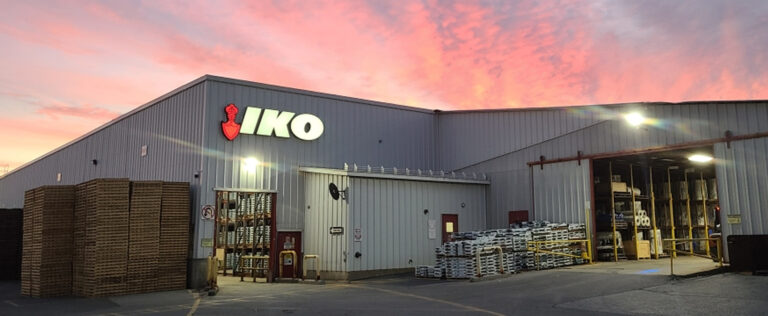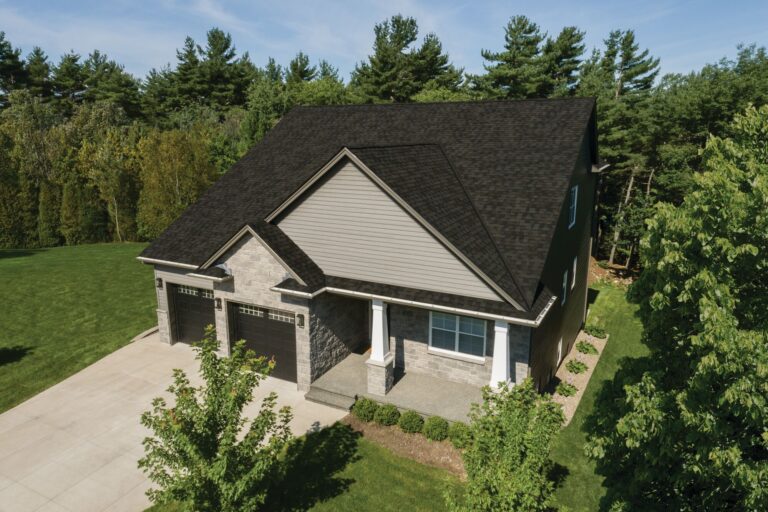Roofing Terms
A | B | C | D | E | F | G | H | I | J | K | L | M | N | O | P | Q | R | S | T | U | V | W | XYZ
A
Algae Discoloration:
A type of black roof discoloration caused by algae. Sometimes referred to as fungus growth.
American Method:
Application of giant individual shingles with the long dimension parallel to the rake. Shingles are applied with a 3/4″ (19 mm) space between adjacent shingles in a course.
APP:
Atactic polypropylene. A plastic polymer used in the modification of asphalt.
ASTM:
Previously known as American Society for Testing and Materials, ASTM International is a voluntary organization concerned with development of consensus standards, testing procedures, and specifications.
Asphalt:
A bituminous waterproofing agent applied to roofing materials during manufacture.
Asphalt Plastic Cement:
An asphalt-based cement used to bond roofing materials. Also known as flashing cement or mastic; typically conforms to ASTM D 4586 (Asbestos Free) or CGSB 37-GP-5MA.
Asphalt Roofing Cement:
An asphalt-based cement used to bond roofing materials. Also known as flashing cement or mastic; should conform to ASTM D 4586 (Asbestos Free) or ASTM D 2822 (Asbestos Containing) or CGSB 37-GP-5MA.
B
Backsurfacing:
Fine mineral matter applied to the back side of shingles to keep them from sticking together. IKO uses backsurfacing materials such as dolomite and mineral fines.
Base Flashing:
That portion of the flashing attached to or resting on the deck to direct the flow of water onto the roof covering.
Blisters:
Bubbles that may appear on the surface of asphalt roofing after installation.
Brands:
Airborne burning embers released from a fire.
Bridging:
A method of re-roofing with larger-sized shingles.
Bundle:
A package of shingles.
Butt Edge:
The lower edge of the shingle tabs.
C
CAN:
This designation in front of a CSA, CGSB or ULC represents that it is a Canadian national standard.
Caulk:
To fill a joint with mastic or asphalt cement to prevent leaks.
Chalk Line:
A line made on the roof by snapping a taut string or cord dusted with chalk. Used for alignment purposes.
Class “A”:
The highest fire-resistance rating for roofing as per ASTM E 108 or ULC S107. Indicates roofing is able to withstand severe exposure to fire originating from sources outside the building. All of IKO’s fiberglass shingles qualify as Class A roof coverings when installed according to our application instructions.
Class “B”:
Fire-resistance rating that indicates roofing materials are able to withstand moderate exposure to fire originating from sources outside the building.
Class “C”:
Fire-resistance rating that indicates roofing material is able to withstand light exposure to fire originating from sources outside the building.
Closed Cut Valley:
A method of valley treatment in which shingles from one side of the valley extend across the valley while shingles from the other side are trimmed 50 mm (2″) from the valley centerline. The valley flashing is not exposed.
Coating:
A layer of viscous asphalt applied to the base material into which granules or other surfacing is embedded.
Collar:
Pre-formed flange placed over a vent pipe to seal the roof around the vent pipe opening. Also called a vent sleeve.
Concealed Nail Method:
Application of roll roofing in which all nails are driven into the underlying course of roofing, and covered by a cemented, overlapped course. Nails are not exposed to the weather.
Condensation:
The change of water from vapor to liquid when warm, moisture-laden air comes in contact with a cold surface.
Counter Flashing:
That portion of the flashing attached to a vertical surface to prevent water from migrating behind the base flashing.
Course:
A row of shingles or roll roofing running the length of the roof.
Coverage:
A mount of weather protection provided by the roofing material. Depends on the number of layers of material between the exposed surface of the roofing and the deck; i.e., single coverage, double coverage, etc.
Cricket:
A peaked saddle construction at the back of a chimney to prevent the accumulation of snow and ice, and to deflect water around the chimney.
CSA:
Canadian Standards Association. A voluntary organization concerned with development of consensus standards, testing procedures and specifications.
Cut-out:
The open portions of a strip shingle between the tabs.
D
Deck:
The wooden surface, installed over the supporting framing members, to which the roofing is applied.
Dormer:
A framed window unit projecting through the sloping plane of a roof
Double Coverage:
Application of asphalt roofing such that the lapped portion is at least 2″ (50 mm) wider than the exposed portion, resulting in two layers of roofing material attached to the deck.
Downspout:
A pipe for draining water from roof gutters. Also called a leader.
Drip Edge:
A non-corrosive, non-staining material used along the eaves and rakes to allow water run-off to drip clear of underlying construction.
E
Eaves:
The horizontal, lower edge of a sloped roof.
Eaves Flashing:
Additional layer of roofing material applied at the eaves to help prevent damage from water back-up.
Edging Strips:
Boards nailed along eaves and rakes (after cutting back existing wood shingles) to provide secure edges for re-roofing with asphalt shingles.
Ell:
An extension of a building at right angles to its length.
Exposed Nail Method:
Application of roll roofing in which all nails are driven into the cemented, overlapping course of roofing. Nails are exposed to the weather.
Exposure:
That portion of the roofing exposed to the weather after installation. For example, the exposure of IKO’s Cambridge shingles is 149 mm (5-7/8”).
Exposure I Grade Plywood:
Type of plywood approved by the American Plywood Association for exterior use.
F
Felt:
Fiberous material saturated with asphalt and used as an underlayment or sheathing paper, such as IKO’s AM #15 Asphalt Felt.
Fiberglass Mat:
An asphalt roofing base material manufactured from glass fibers.
Flashing:
Pieces of metal or roll roofing used to prevent seepage of water into a building around any intersection or projection in a roof such as vent pipes, chimneys, adjoining walls, dormers, and valleys. Galvanized metal flashing should be minimum 28-gauge.
FM:
Factory Mutual Research Corporation is a scientific research and testing facility that works with commercial and industrial clients to ensure that their products and services meet standards and approvals. For roofing systems and products, Factory Mutual provides testing and certification services for items such as fire resistance, wind resistance, and impact resistance.
G
Gable:
The upper portion of a sidewall that comes to a triangular point at the ridge of a sloping roof.
Gable Roof:
A type of roof containing sloping planes of the same pitch on each side of the ridge. Contains a gable at each end.
Gambrel Roof:
A type of roof containing two sloping planes of different pitches on each side of the ridge. The lower plane has a steeper slope than the upper. Contains a gable at each end.
Granules:
Ceramic-coated colored crushed rock that is applied to the exposed surface of asphalt roofing products. IKO makes its own granules at our Madoc, Ontario, and Ashcroft, British Columbia granule plants. Granules protect the asphalt coating from the sun’s rays, add color to the product and enhance fire resistance.
Gutter:
The trough that channels water from the eaves to the downspout. Also known as an eavestrough.
H
Headlap:
Shortest distance from the butt edge of an overlapping shingle to the upper edge of a shingle in the second course below. The triple coverage portion of the top lap of strip shingles.
Hip:
The inclined external angle formed by the intersection of two sloping roof planes. Runs from the ridge to the eaves.
Hip Roof:
A type of roof containing sloping planes of the same pitch on each of four sides. Contains no gables.
Hip Shingles:
Shingles used to cover the inclined external angle formed by the intersection of two sloping roof planes. IKO makes specific Hip and Ridge, Hip & Ridge 12 and UltraHP™ shingles for this purpose.
I
Ice Dam:
Condition formed at the lower roof edge by the thawing and re-freezing of melted snow on the overhang. Can force water up and under shingles, causing leaks.
L
Laminated Shingles:
Strip shingles containing more than one layer of tabs to create extra thickness. Also called three-dimensional shingles or architectural shingles. IKO’s Crowne Slate, Dynasty with Armourzone, Cambridge, Nordic, Royal Estate and Armourshake are all laminated shingles.
Low Slope Application:
Method of installing asphalt shingles on roof slopes 2:12 (9.5°) – 4:12 (18.4°).
M
Mansard Roof:
A type of roof containing two sloping planes of different pitch on each of four sides. The lower plane has a much steeper pitch than the upper, often approaching vertical. Contains no gables.
Mineral-Surfaced Roofing:
Asphalt shingles and rolled roofing that are covered with granules.
N
Nesting:
A method of re-roofing with new asphalt shingles over old shingles in which the top edge of the new shingle is butted against the bottom edge of the existing shingle tab.
O
Offset:
The distance between the edge of one shingle course and the edge of the next successive shingle course.
Open Valley:
Method of valley construction in which shingles on both sides of the valley are trimmed along a chalk line snapped on each side of the valley. Shingles do not extend across the valley. Valley flashing is exposed.
R
Racking:
Roofing application method in which shingle courses are applied vertically up the roof rather than across and up. Typically, this is not a recommended procedure.
Rake:
The inclined edge of a sloped roof over a wall.
Release Tape:
A plastic film strip that is applied to the back of self-sealing shingles. This strip prevents the shingles from sticking together in the bundles only, and does not need to be removed for application.
Ridge:
The uppermost, horizontal external angle formed by the intersection of two sloping roof planes.
Rise:
The vertical distance from the eaves line to the ridge.
Run:
The horizontal distance from the eaves to a point directly under the ridge. One half the span.
S
Self-Adhered Eave and Flashing Membrane:
A self-adhering bituminous waterproofing shingle underlayment designed to protect against water infiltration due to ice dams and wind-driven rain. IKO offers three ice and water protector products: GoldShield, ArmourGard and StormShield, which are generally available in various sizes.
Self-Sealing Strip or Spot:
Factory-applied adhesive that bonds shingle courses together when exposed to the heat of the sun after application.
Shading:
Slight differences in shingle color that may occur as a result of normal manufacturing operations.
Slope:
The degree of roof incline expressed as the ratio of the rise, in inches, to the run, in inches. (e.g. 18.5° (4:12) slope)
Soffit:
The finished underside of the eaves, which should contain holes or perforations to provide air intake for attic ventilation.
Starter Strip:
Asphalt roofing applied at the eaves that provides protection by filling in the spaces under the cut-outs and joints of the first course of shingles. IKO’s Leading Edge Plus is a pre-made starter strip product ideally suited for this application.
Step Flashing:
Flashing application method used where a vertical surface meets a sloping roof plane.
T
Tab:
The exposed portion of strip shingles defined by cut-outs.
U
Underlayment:
Asphalt saturated felt, such as IKO’s AM #15 Asphalt Saturated Felt, RoofGard-Cool Grey Synthetic Underlayment, or Stormtite Sythetic Underlayment used beneath roofing to provide additional protection for the deck.
V
Valley:
The internal angle formed by the intersection of two sloping roof planes.
Vent:
Any outlet for air that protrudes through the roof deck such as a pipe or stack. Any device installed on the roof, gable or soffit for the purpose of ventilating the underside of the roof deck.
W
Woven Valley:
Method of valley construction in which shingles from both sides of the valley extend across the valley and are woven together by overlapping alternate courses as they are applied. The valley flashing is not exposed.
Want to learn more about commercial roofing? Read our Commercial Roofing Glossary.


